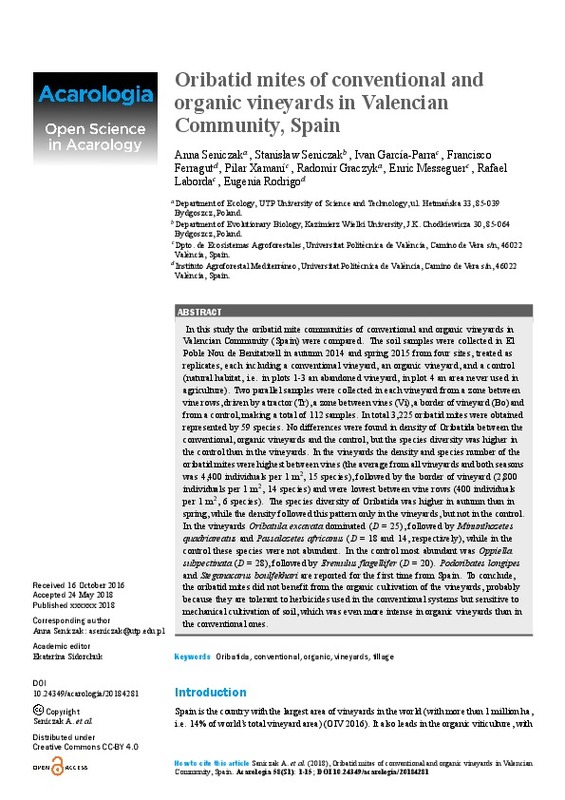JavaScript is disabled for your browser. Some features of this site may not work without it.
Buscar en RiuNet
Listar
Mi cuenta
Estadísticas
Ayuda RiuNet
Admin. UPV
Oribatid mites of conventional and organic vineyards in Valencian Community, Spain
Mostrar el registro sencillo del ítem
Ficheros en el ítem
| dc.contributor.author | Seniczak, A.
|
es_ES |
| dc.contributor.author | Seniczak, S.
|
es_ES |
| dc.contributor.author | Garcia-Parra, I.
|
es_ES |
| dc.contributor.author | Ferragut Pérez, Francisco José
|
es_ES |
| dc.contributor.author | Xamani Monserrat, Pilar
|
es_ES |
| dc.contributor.author | Graczyk, R.
|
es_ES |
| dc.contributor.author | Meseguer-Cervera, Enric
|
es_ES |
| dc.contributor.author | Laborda Cenjor, Rafael
|
es_ES |
| dc.contributor.author | Rodrigo Santamalia, Mª Eugenia
|
es_ES |
| dc.date.accessioned | 2019-05-31T20:42:34Z | |
| dc.date.available | 2019-05-31T20:42:34Z | |
| dc.date.issued | 2018 | es_ES |
| dc.identifier.issn | 0044-586X | es_ES |
| dc.identifier.uri | http://hdl.handle.net/10251/121349 | |
| dc.description.abstract | [EN] In this study the oribatid mite communities of conventional and organic vineyards in Valencian Community (Spain) were compared. The soil samples were collected in El Poble Nou de Benitatxell in autumn 2014 and spring 2015 from four sites, treated as replicates, each including a conventional vineyard, an organic vineyard, and a control (natural habitat, i.e. in plots 1-3 an abandoned vineyard, in plot 4 an area never used in agriculture). Two parallel samples were collected in each vineyard from a zone between vine rows, driven by a tractor (Tr), a zone between vines (Vi), a border of vineyard (Bo) and from a control, making a total of 112 samples. In total 3,225 oribatid mites were obtained represented by 59 species. No differences were found in density of Oribatida between the conventional, organic vineyards and the control, but the species diversity was higher in the control than in the vineyards. In the vineyards the density and species number of the oribatid mites were highest between vines (the average from all vineyards and both seasons was 4,400 individuals per 1 m2, 15 species), followed by the border of vineyard (2,800 individuals per 1 m2, 14 species) and were lowest between vine rows (400 individuals per 1 m2, 6 species). The species diversity of Oribatida was higher in autumn than in spring, while the density followed this pattern only in the vineyards, but not in the control. In the vineyards Oribatula excavata dominated (D = 25), followed by Minunthozetes quadriareatus and Passalozetes africanus (D = 18 and 14, respectively), while in the control these species were not abundant. In the control most abundant was Oppiella subpectinata (D = 28), followed by Eremulus flagellifer (D = 20). Podoribates longipes and Steganacarus boulfekhari are reported for the first time from Spain. To conclude, the oribatid mites did not benefit from the organic cultivation of the vineyards, probably because they are tolerant to herbicides used in the conventional systems but sensitive to mechanical cultivation of soil, which was even more intense in organic vineyards than in the conventional ones. | es_ES |
| dc.language | Inglés | es_ES |
| dc.publisher | EDP Sciences | es_ES |
| dc.relation.ispartof | Acarologia | es_ES |
| dc.rights | Reconocimiento (by) | es_ES |
| dc.subject | Oribatida | es_ES |
| dc.subject | Conventional | es_ES |
| dc.subject | Organic | es_ES |
| dc.subject | Vineyards | es_ES |
| dc.subject | Tillage | es_ES |
| dc.subject.classification | PRODUCCION VEGETAL | es_ES |
| dc.title | Oribatid mites of conventional and organic vineyards in Valencian Community, Spain | es_ES |
| dc.type | Artículo | es_ES |
| dc.identifier.doi | 10.24349/acarologia/20184281 | es_ES |
| dc.rights.accessRights | Abierto | es_ES |
| dc.contributor.affiliation | Universitat Politècnica de València. Departamento de Ecosistemas Agroforestales - Departament d'Ecosistemes Agroforestals | es_ES |
| dc.description.bibliographicCitation | Seniczak, A.; Seniczak, S.; Garcia-Parra, I.; Ferragut Pérez, FJ.; Xamani Monserrat, P.; Graczyk, R.; Meseguer-Cervera, E.... (2018). Oribatid mites of conventional and organic vineyards in Valencian Community, Spain. Acarologia. 58(S):119-133. https://doi.org/10.24349/acarologia/20184281 | es_ES |
| dc.description.accrualMethod | S | es_ES |
| dc.relation.publisherversion | http://doi.org/10.24349/acarologia/20184281 | es_ES |
| dc.description.upvformatpinicio | 119 | es_ES |
| dc.description.upvformatpfin | 133 | es_ES |
| dc.type.version | info:eu-repo/semantics/publishedVersion | es_ES |
| dc.description.volume | 58 | es_ES |
| dc.description.issue | S | es_ES |
| dc.relation.pasarela | S\377555 | es_ES |








